Fishing Tubes Is A Shallow Water Smallmouth Technique, Right?
Well, Yes and No
Fishing tubes or gitzits is commonly thought of as a bass fishing technique for clear water and rocky structure when targeting smallmouth bass. Tubes are also effective for largemouth and fished in just about any type of cover as well.
Tube baits can be fished Texas rigged, on Carolina rigs, as a drop-shot bait, on the end of a split-shot rig, flipped, pitched and are a great "skipping" lure.
What About Tube Lures Appeals To Bass?
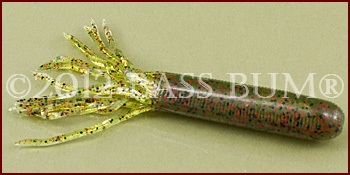
For such a non-descript lure, a tube fishing lure exhibits unexpected "action" as an angler works it and can often entice strikes from even finicky bass.
First, the hollow body contributes to the "float" of the lure. They don't actually float but the hollowness creates a "lightness" that results in a "back and forth" swing and flutter during the drop and a wild darting this way or that when given a slight twitch. This erratic movement attracts the attention of bass.
Secondly, besides being hollow and rounded closed on one end, tubes are, depending on their length, about 30-40% tentacles on the other end. These are ever moving in the water creating vibration that bass can sense as well as see. Remember the "lateral line" bass have to augment their ability to "see and hear"?
Lastly, the hollow structure allows for inserting objects that can enhance the "attraction" quality of these lures. Over the years anglers have placed Alka-Seltzer tablet chips in them in order to have bubbles flowing out of its backside. Cotton balls soaked in "scents" also find their way stuffed up the backside of tubes. There are even tube rattles available for this "stuffing' and if you want them to actually float, then cram a bit of styrofoam, like an ear plug, up its butt

Tubes Are Hollow. How Do You Rig Them With Hooks?
There are numerous ways to rig hollow tube lures with hooks. You will find many explained and illustrated by clicking here to learn more about the basics of tube baits and how to rig them.

When Is The Best Time For Fishing Tubes?
In early spring before spawn or when bass are holding close to cover in fall are the best times for fishing tubes. Otherwise, anytime bass are to be found shallow is good. Of course tube baits are favorites of anglers who sight fish spawning beds in the spring, something I do rarely.
It's smart to always have a tube bait rigged and ready on your deck as a "follow-up" or "fall-back" lure. Like the commercial says, "Don't leave home without it", a tube that is.

How and Where Do You Fish Tubes?
Texas Rigged Tubes
Texas rigging a tube on an EWG hook with a "sliding" 1/16, 1/8 or 1/4 ounce bullet sinker is better in grass and other moderately "heavy" cover than the open hook of a "tube jig". A Texas rigged tube will work its way through pockets and openings in grass much like a plastic worm. Be sure to "skin" the hook point so it's weedless. It's also a good rig for fishing tubes around docks and overhead cover and can also be used for "skipping". Let the tube "drop" on controlled slack. If not "bit" on the drop let it sit for a short time before jiggling it. "Lift and drop" it back to the boat.
Some anglers insist on "pegging" their bullet sinker when fishing tubes in cover. They feel this prevents the sinker from slipping to the bottom while the tube hangs on or over branches of grass. Setting the hook on a strike when the sinker and tube are separated like this is difficult.
Try both ways and go with the one that works best for you "in your hands".
If the cover is sparse and the water clear a 6'6" or 7' spinning rod with 10lb test monofilament, or even better, fluorocarbon line, is good gear for fishing tubes that are Texas rigged. My tackle is an All Star TAS 785S 6'6", fast-medium spinning rod and a Diawa SS1600 reel.
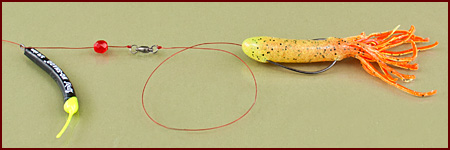
Carolina Rig
Fishing tubes on a Carolina Rig is frowned upon by some anglers. However, tubes work especially well in water deeper than 15'. Drag it around vegetation or rocks behind a 1/4 to 1/2 ounce sinker on monofilament line with a fluorocarbon leader. This technique can be particularly effective if you use a "floating tube". You might try using a heavier Mojo sinker that is pegged "up the line" a ways from the hook.
I use a somewhat heavy spinning outfit for this which includes a Shimano Sustain 4000FD on a G.Loomis GLX BSR852, 7'1" extra-fast rod.
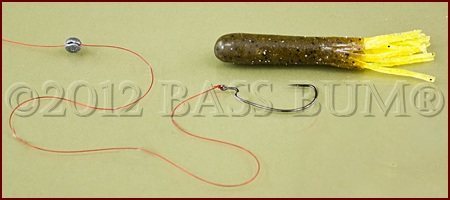
Split Shot Rig
Fishing tubes on split shot rigs excels in catching bass located on inside and outside weed lines. Use a 4" thin walled tube here, not a thick walled "flipping" tube. Cast to the inside edge and slowly drag the tube along the edge of the grass.
A medium, fast action spinning rod and size 2500 spinning reel with 10lb monofilament make for a good rig here.
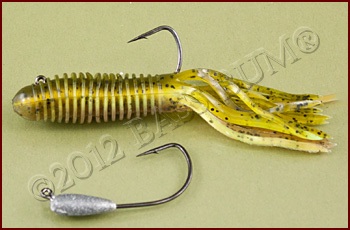
Tube Jigs
An open end tube rigged on a jig head is a very common method of fishing tubes. A jig head is inserted in the open butt of the tube, pushed all the way against the head and the eyelet popped through the wall of the tube. These are most effective in water less than 15' deep around sparse cover, docks, 'laydowns' and other shoreline cover. They will often be struck on the drop so be a line watcher.
I use a medium, fast action, 6'6" spinning rod for this matched with a medium size spinning reel spooled with 10lb monofilament. If fishing light to moderately light grass for largemouth I use a 4" standard wall tube with a 1/8 or 3/16 ounce jig head and 2/0 hook, though others will use shorter tubes for this. I don't use "thick-walled, big headed flipping tubes here. Those are designed for "flipping" in heavier cover situations and are often Texas rigged with sinkers pegged tight to the head of the tube.
When I'm bass fishing tubes are always on the menu I offer bass. I'll cast jig tubes into grass but not let them sink. Instead, I'll begin my retrieve as soon as the tube lands making small jerks and occasionally allowing it to sink below the surface of the grass, then jerking. If the tube hangs on the grass, by jerking it free and creating commotion you will sometimes trigger strikes from otherwise inactive bass.
If you're fishing tube jigs around rock piles or flats use a swimming retrieve whle raising and lowering your rod tip. This will make the tube undulate up and down much like a baitfish.
Tube and Spider Grub Football Head Jigs - Great For Fishing Rocks
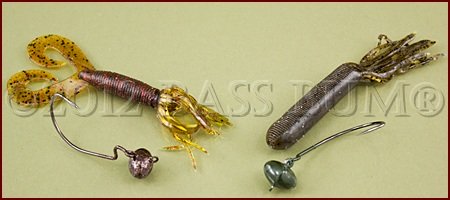
Another good way of fishing tubes on rock strewn bottoms, especially thin walled tubes, is on a football jig head. As you crawl it across the bottom the tube will raise and lower its fluttering tentacles as the jig bumps, hesitates then moves clear of rocks.

Learn to Skip Tubes
You'll Catch Bass Where They Hide
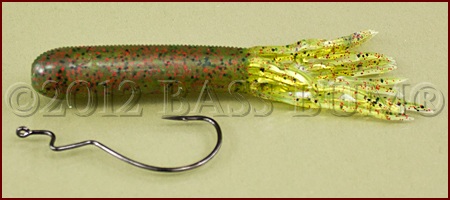
Bass retreat under shoreline cover to escape the sun and make themselves less visible to prey as well as hide from their own predators. Reaching these bass with traditional casting, flipping or pitching is limited by the required trajectory of the cast. What is needed is a "low trajectory" cast that virtually eliminates the required large angle when casting or flipping in the presence of overhanging cover, ropes on docks or while trying to access the far reaches of a boat slip.
Gitzits well skipped create virtually no splash and mimics a baitfish frantically scurrying across the water's surface. Bass take notice. Tubes are like rocks. The smoothest rocks skip the best and the smooth surface and sleek shape of tubes meet little water resistance when skipped.
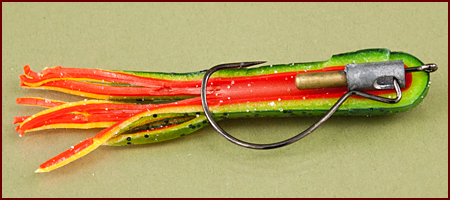
Tex-Pose the Hook And Add A Little Weight
If you're going to skip tubes successfully you must add some weight and eliminate snagging by Tex-Posing the hook point. You can use weighted hooks like swim bait hooks, but better is to place weights "inside" the tube. These can be a split-shot or bullet worm weight pushed into the tube and secured with scent soaked cotton.
A better way I think is shown in the cut-away image at above. It shows a tube with an internal weight and integral rattle chamber paired with a Gamakatsu "Skip Gap" hook. This set up has worked very well for me despite the aggravation of trying to get the hook point through the sinker's eye while it's inside the tube.
Skipping Tubes, Not As Easy As Skipping Rocks, But Then Again, I Never Caught A Bass With A Rock
You need proper gear before you can master this technique of fishing tubes. For a rod use a short spinning rod 5 1/2' to 6' in length. Though you can use any length, shorter rods give you more control than do longer models. A model with a fast tip that will load up with the snap of a wrist and unload quickly will best propel the tube toward your target. Fluorocarbon line is a good choice for skipping.
The Side Arm Cast
- Dangle 6-12" of line from your rod tip.
- Grasp the rod handle with both hands while pointing its tip downward.
- Begin a side arm cast spinning the tube on the line so that it begins rotating around the rod tip clockwise.
- Simultaneously, pull the rod backwards and when the tube is half way through its rotation snap the rod tip forward unloading the rod.
- If correctly cast with a low angle between the tube and water the tube should propel rapidly forward contacting the water within a couple of skips of your target.
Skipping works best when the
water is calm or has slight ripples. The technique takes practice and
patience but the rewards once mastered can be great.

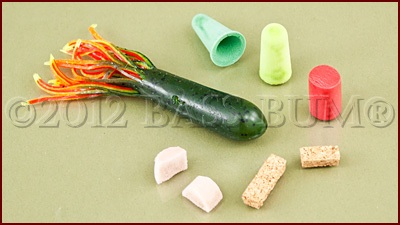
It was inevitable that the hollow nature of tubes would lead to angler tinkering. Most all plastic baits sink, with the exception of a few that are injected with huge quantities of air bubbles like Gene Larew's "floating tube". However, it's easy to make your tube baits float by inserting pieces of cork or styrofoam in the hollow body.
Fishing tubes that float above the bottom are bass attractors. On the end of a Carolina rig or split shot rig they will dip when the rig is "crawled" but slowly rise again on the pause with tentacles undulating enticingly.
Anglers have put Alka-Seltzer chips and scent soaked cotton inside tube lures. While these things may not actually help you "hook" bass, they do attract the attention of bass. Getting their attention is the first step towards catching them, right?
Return To Bass Fishing Techniques From Fishing Tubes
